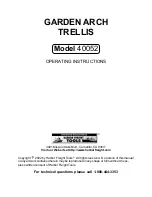
4 Checking Continuity performance
4.1 The need to null test leads
It is essential to either null the leads or deduct the lead resistance from the measured value so
that the check on the accuracy of the instrument is not affected by the test leads used. This
is because the resistance of the leads may vary with use or the leads may be replaced during
the lifetime of the instrument.
The FC2000 includes a ‘lead null’ position for the continuity test range. This can be used
either to null the leads if the test instrument being checked includes a lead-null function or to
measure the lead resistance for instruments without this function. Follow section 4.2 or 4.3 as
appropriate for your instrument.
4.2 Instruments with a lead null function
4.2.1 Lead nulling
• The leads should be connected to the instrument in the normal way.
• One lead should be connected to the null terminal in the continuity range.
• The other lead is then connected to the null terminal in the insulation resistance
range. This provides a direct link between the two leads and allows them to be nulled.
• Null the leads according to the instrument manufacturer’s instructions.
Once the leads have been nulled and providing the instrument is not switched off,
there will be no need to subtract the test lead values from the measured values as
the instrument should automatically deduct the resistance value of the test leads
from any further measurements.
If the instrument is switched off the null process will need to be repeated.
4.2.2 Continuity check
• The null terminal in the continuity range is also the common terminal used for the con-
tinuity measurement. One instrument test lead should be connected to this common
terminal.
• The other instrument test lead should firstly be connected to the 0.5Ω terminal.
• The instrument to be checked should be set to the most appropriate scale and the
continuity test carried out in the normal way.
• The value obtained should be recorded on the test instrument record sheet.
• The same procedure should be followed using the 1Ω and 2Ω terminals.
• The recorded values are compared with the reference values to assess the perfor-
mance of the instrument over time.
• If the measured values are found to be within the manufacturer’s tolerance then the
instrument is suitable for continued use.
• If any of the measured values are outside the manufacturer’s tolerance then the instru-
ment will need to be returned for calibration.
4.3 Instruments without lead null function
4.3. 1 Measuring lead resistance
Where there is no lead null option on the instrument to be checked the null terminals can be
used to establish the resistance of the test leads.
• With the leads connected to the instrument in the normal way one lead should be con-
nected to the null terminal in the continuity range and the other lead connected to the
null terminal in the insulation resistance range.
• The instrument should then be set to the lowest resistance scale and operated in the
normal way.
• The value measured by the instrument will be the resistance of the test leads. Make
a note of this value as it must be subtracted from the check values obtained when
checking at the three test values.
4.3.2 Continuity check
• The null terminal in the continuity range is also the common terminal used for the
continuity measurement. One instrument test lead should be connected to this com-
mon terminal.
• The other instrument test lead should firstly be connected to the 0.5Ω terminal.
• The instrument to be checked should be set to the most appropriate scale and the
continuity test carried out in the normal way.
• Subtract the resistance value of the leads that you previously measured from the
instrument reading. The value obtained should be recorded on the test instrument
record sheet.
• The same procedure should be followed using the 1Ω and 2Ω terminals.
• The recorded values are compared with the reference values to assess the perfor-
mance of the instrument over time.
• If the measured values are found to be within the manufacturer’s tolerance then the
instrument is suitable for continued use.
• If any of the measured values are outside the manufacturer’s tolerance then the
instrument will need to be returned for calibration.
4.4 Tolerance examples
If the instrument tolerance is 2% then the measured value should be within ± 2% of the refer-
ence value. So if the reference value is 0.5Ω the measured value should be between 0.51Ω
and 0.49Ω.
If the instrument tolerance is 2% ± 20mΩ then the measured value should be within ± 2% and
± 20mΩ of the reference value. So if the reference value is 0.5Ω the measured value should
be between 0.53Ω and 0.47Ω.
























